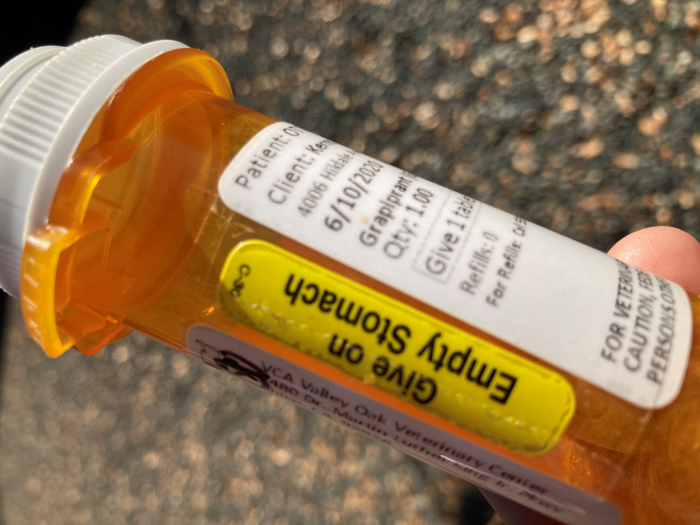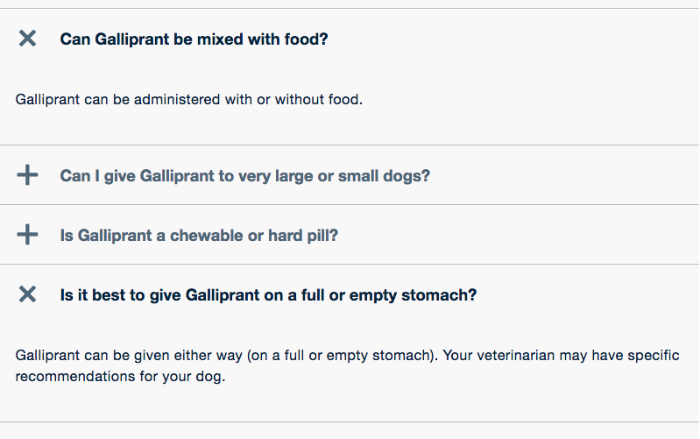The last time my senior dog, Otto, had a wellness examination, our veterinarian recommended that I start giving him a medication that treats arthritis pain – at least on the days when he exercises more than usual, like when I take him on off-leash hikes. She recommended a newish drug, Galliprant, a nonsteroidal anti-inflammatory drug (NSAID) that works with a slightly different mechanism than most NSAIDs prescribed for dogs, and is supposed to have less of an impact on dogs’ kidneys and livers. I ended up taking home a bottle that contained 30 chewable tablets of the medication.
I’ve been giving the medication to Otto occasionally, on days when we’ve taken a hike, or when he seemed particularly stiff or gimpy in the morning. This has been happening more frequently with the cold weather, and I was down to just a few tablets, so I picked up the bottle the other day to call in a refill.
As I waited on the phone for the veterinary receptionist to help me, listening to the clinic’s “hold” music, bottle of medication in my hand, I idly scanned the label, looking to identify the prescription number. To my horror, I saw this:

“Give on Empty Stomach.”
I have been giving the medication to Otto in the morning, with his breakfast – despite a yellow banner on the label that said to give the medicine to him without food.
I don’t know when or why I started giving him the medication with food. Did I not listen to my vet’s instructions? Was I distracted when we were discussing the medication? All I remember hearing is “one tablet given once daily.” Why didn’t I review the label instructions before I gave him any? How could I not notice the yellow label?!
Fortunately, as it turns out, this particular instruction wasn’t critical. When the receptionist came on the line, I told her I was looking for a refill but also wished to speak to the veterinarian briefly about the “empty stomach” instruction. When the doctor became available, she reassured me that the medication could be given either way – but that in her personal experience, she thought it was more effective given on an empty stomach. As long as it was working for Otto, she wasn’t concerned.
Still feeling like a bad dog mom and not to be mollified that easily, I pulled up the drug’s website, which states pretty clearly that it doesn’t matter whether the drug is given with food or not. So now I feel better.

But the issue scared me enough to pass along this advice. Take this opportunity to check the label of any medications your dog receives, right now! Check the dosage and number of pills, the number of times a day your dog is supposed to receive them, and the expiration date (if applicable) of any medication he receives only “as needed.”
Still troubled about my (as it turns out, harmless) screwup with Otto’s medication, I mentioned my error to a couple of friends – and one admitted she once, a few years before, dosed her dog with half of the medication that the label called for, at least half-way through the bottle. It was a two-week prescription, and only when it seemed like the bottle wouldn’t be empty in a week’s time did she examine the label more carefully. The dog was supposed to get two capsules, twice a day, and she had been giving only one capsule twice a day. She admitted her error to her vet, who told her to come and pick up more of the medication, so the dog could receive the full dose for the entire recommended period, as a half dose wasn’t likely to be effective.
Learn from our mistakes! Check those labels!






Wonderful, what a web site it is! This website
gives useful data to us, keep it up.
Thanks. Loved the content
I think you were being a good dog Mom by rote as it is most typical to give medications WITH food to prevent gastric upset, particularly arthritis medications. Just my opinion.
Ideally, take NSAIDs after eating and avoid taking them on an empty stomach. This will help minimize the risk of the medicine upsetting your stomach.
No medicine is harmless for dogs stomach (nor ours), so we can only tread in between, trying to help the ailment and not make a problem elsewhere…songive it and take it with food.
I’d add to that: be mindful when you’re giving medication. One morning I was distracted and mistakenly took my dog’s medication! I called the poison control hotline and was reassured that it wouldn’t be a problem for me but I sure felt stupid. Now I make sure to focus on what I’m doing.
Instead of having the vet refill, check Costco or your favorite drug store, and check good RX …….could be a lot cheaper.
Second this. Tramadol, Gabapentin, Carprofen are all people meds. Some are given to dogs off label, so you could get their Rx filled in a regular pharmacy. I have a local Costco so when Ramses went on one of the meds that’s where I went. It was cheaper but for one they had them in a pill that disintegrated when I cut it so returned them. They didn’t have one in the dosage he needed. Since they dispense for people you need to check on the form, capsules, pills, etc and if they will have to be cut to be the correct dosage. For poor Ramses, at least a third of the pills crumbled into pieces so fine it was impossible to gauge what was half a pill. For the price, losing a third of the prescription wasn’t saving any money but costing me money.
Make sure you also recognize what the medicine is supposed to look like… often times the pills will be different because of different manufacturers…but it could just be the wrong pill
Yes also who has heard about the fact that heartguard brand MUST be chewed or it is not effective? Its in fine print on the box and package insert but if a person only gets a few at a time, such as those who might not want to treat all year round, one would not know and I have never had a vet tell me that they needed to be chewed. I would venture to say that maybe even most vets do not know this little tidbit of information. I switched to tri-heart for this reason as it does not need to be chewed. My dog does not chew anything and inhales treats and food. I also only give her a few a year during the high risk transmission months in Maine. Best advice is to read package inserts whenever possible. There is a lot we are not told, even with regard to human meds.
GREAT TIPS, everyone! Keep them coming!
Also be very careful about the dosage. My former vet had prescribed 6 milligram tablets of a med for my small dog and the tech gave me 60 milligram tablets. Thank god I researched and found out that dosage was wrong and would of killed my poor dog. Scared me to death. So now I always double-check.
and do the sam thing for your own meds, and that of your family. You’d be surprised how common this is.
I am a retired pharmacist. If only patients or parents would read the label! Most importantly, accept counseling from your pharmacist! We have so much information to give you and, it’s our job! So the next time you have a new prescription filled, make sure you accept counseling from your pharmacist!
My concern is that this new drug is supposed to have fewer side effects as Rimadyl or Meticam. I will not use either of these two meds and would be extremely careful with any other NSAID. I have heard too many horror stories using these two meds. My go to is Tramadol for pain and herbs and Hyaluronic Acid for joints. There are some other good glucosamine, MSM and condroi products too. My vets all want to push Rimidyl or Meticam. I would not use them at all until very recently and only for a very few days.
Just like in people. you have to be careful of interractions.
When Ramses went from Carprofen to an opiod I had to withhold the Carprofen for 10 days to make sure it was out of his system before starting the new meds because opiods and NSAIDs do NOT mix. Tramadol is a synthetic Opiod and should never be given with an NSAID.
Both Candy and Ramses ended up taking Tramadol but they had to stop the Gabapentin (Candy) and Carprofen (Ramses) for 10 days first. Tramadol is a narcotic and should never be mixed with an NSAID.
What you really need to watch out for is Prednisone. I only gave that to Ramses twice and then immediately stopped. I can’t tolerate it either.
Not only do I read the entire label (not only of my dog’s medication but also any new medication I might be given) but I also google it and read several medical websites on the drug, it’s interactions and side effects.. Doctors and vets don’t always tell you about side effects and interactions. (For this reason I stopped taking one medication I was given as it was likely to increase my chances of diabetes by 60%!)
My parent’s dog was on Galliprant and mine was on Carprofen (generic for Rimadyl). both did well on it and it allowed for an increase in doseage as they got older.
Otto will do well. I will suggest you monitor him as at some point he will need to be taking it on a regular basis, rather than just occasionally and it is easy to miss the signs. Also that at some point you will need to increase it a bit. A big regret I will hold forever is that I didn’t start Ramses on it sooner and that I didn’t increase his dosage sooner. By the time he had an x-ray I had no idea how much pain he must have been in, given the deterioration of the discs in his spine. The medication did work and I am glad I did increase it eventually.
With every dog I learn. I’ve heard trainers say “With my new dog I’m not doing agility.”
Diana pawPrints is now 100 lbs and not allowed on the bed. Not because of the bed but because I don’t want her spending 10 years jumping OFF of the bed and thus, risking arthritis and an injured spine after doing it for 10 years. If I can get a ramp built in the bedroom, then she will be allowed on the bed as long as she uses the ramp to get on and off. And she will. She doesn’t like to jump.
I have a 7 year old galgo with polyarthritis due to leishmaniasis. He gets gabapentin for the discomfort, but I cannot treat his arthritis with NSAIDS because he has proteinuria. I was researching Galliprant, but was nervous to try it because of his kidney issues, especially with the meds he’s taking now for his leishmania infection. He’s showing improvement after I started him on Maximum Strength Cosequin, CMO and yucca extract, which also helps to support his immune system. All recommended by a friend who has had great results from holistic supplements.
I have numerous vet recommended supplements I give my dog to support her Addison’s disease, for which she also gets medication. Some are daily, some are alternate days, some are on empty stomach, and some are with meals. I made sticky labels for each bottle cap giving the number of tablets and timing. This has been a big help for me, and if my husband needed to give the meds, he would know exactly what and when.
I always, always read the instructions on bottle, any insert, if provided, and google all meds for myself and for any of my animals. Call me paranoid, but I don’t trust the vet or a doctor or pharmacist to not make mistakes. Knowledge is power and you are ultimately in control of what you or your pets ingest. There have been a few times, throughout the years where some med has been given to me that should not have been, either because of pre existing conditions, breed of dog, (collies and ivermection). previous reaction, etc. This is something we all can control if we are aware
Yeah sometimes is hard to believe in the vet and sometimes they just give anything.
Can we rely in article written by somebody who gives those in their care without reading the directions????
It is ALSO advisable to Google for possible side effects!
With some drugs these can be worse than whatever it is they are treating.
Yea been there do that luckily it was just more effective on a empty stomach. Don’t rember how I caught it been several years.
This is the best blog so far
My pet was on Galliprant for less than a month and developed kidney damage/renal failure as well as all of the drug’s other listed side effects. She became so ill and weak that I had to send her to Heaven. I contacted the FDA and the drug company and reported the kidney damage/renal failure as an Adverse Side Effect. Has anyone else experienced this tragedy? If so, did you report it to the FDA and drug company? If not, please do so.